Potager & Recipes
 The Vegetable Garden is a Great Place to Experiment and Try Something New Each Year
The Vegetable Garden is a Great Place to Experiment and Try Something New Each Year
I grew up in the middle of a strawberry patch. My family raised and sold organic berries and other produce, and I learned to garden by doing. These days my professional life revolves around ornamental horticulture —I design and install all kinds of landscapes and gardens, including potagers— and I see no reason why a vegetable garden can not be both productive and beautiful. Inspired by French, Italian, German and Swiss potagers, my kitchen garden is filled with not only vegetables, herbs and fruit, but also flower pots, furniture and ornaments. Vegetable gardens are sgreat place to hang out, and as I’ve become interested in winter gardening I’ve discovered that I like to spend time in my potager even with 3′ of snow on the ground. Â Collected on this page are past-blog-post images and links to edible gardening articles and recipes. Check back now and again, as I will be regularly updating and adding links and resources.
The more time a gardener spends in the garden, the better the garden. Why not make the kitchen garden an inviting extension of your home: a place not only for working, but also for relaxing and enjoying the fruits of your labor. This need not be expensive! My own garden was created from hand-me-downs, freebies and hand-made objects. Good art and science are all about experimentation. I always try to head out into the garden with an open, curious mind, and child’s enthusiasm…
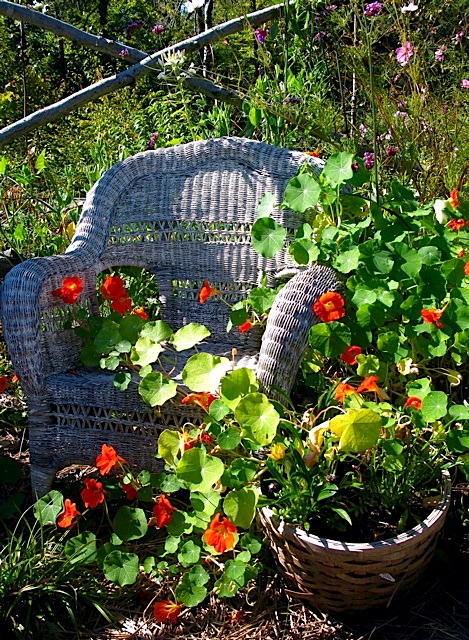 The Nasturtium Seat in my Summertime Potager – Image â“’ Michaela at TGE
The Nasturtium Seat in my Summertime Potager – Image â“’ Michaela at TGE
 Home-Made Compost Love:Â “Composting Basics, For Beginners” (click to article here)
Home-Made Compost Love:Â “Composting Basics, For Beginners” (click to article here)
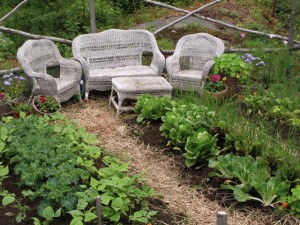 My Kitchen Garden. For creative vegetable gardening ideas, see: Â “The Art & Science of Designing a Vegetable Garden” (click here)
My Kitchen Garden. For creative vegetable gardening ideas, see: Â “The Art & Science of Designing a Vegetable Garden” (click here)
 The single most important thing you can do to grow a great garden, is to build great soil. Does your soil contains the minerals and nutrients your plants needs? Are your plants able to access them? Testing your soil for pH, nitrogen, phosphorus and potassium is key to gardening success. You can do a simple soil test at home (see post here). To further analyze your soil’s structure and make-up, you can send a sample of your soil off to your nearest Extension Service.
The single most important thing you can do to grow a great garden, is to build great soil. Does your soil contains the minerals and nutrients your plants needs? Are your plants able to access them? Testing your soil for pH, nitrogen, phosphorus and potassium is key to gardening success. You can do a simple soil test at home (see post here). To further analyze your soil’s structure and make-up, you can send a sample of your soil off to your nearest Extension Service.
 It’s always a good idea to review seed starting basics before sowing vegetables indoors (click here for article)
It’s always a good idea to review seed starting basics before sowing vegetables indoors (click here for article)
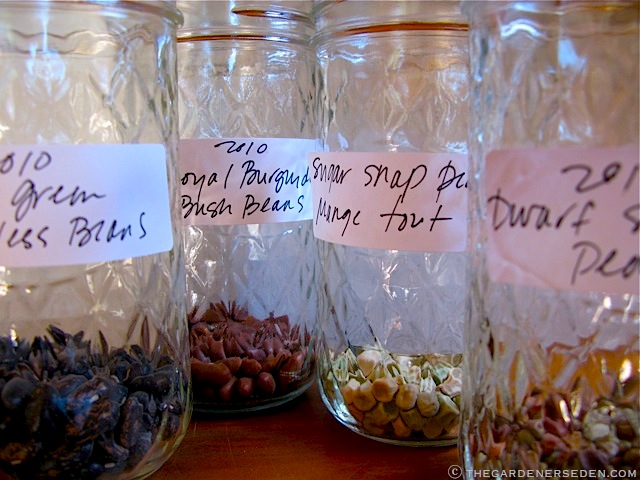 Saving Seed is a great way to “Close the Circle” – Click here for special post on seed saving with great online resources & links!
Saving Seed is a great way to “Close the Circle” – Click here for special post on seed saving with great online resources & links!
 Flowers of all kinds help to attract beneficial insects to the garden. I grow many flowers in my vegetable garden, including edibles like pansies and nasturtiums. Nasturtium Explosion â“’ Michaela at TGE
Flowers of all kinds help to attract beneficial insects to the garden. I grow many flowers in my vegetable garden, including edibles like pansies and nasturtiums. Nasturtium Explosion â“’ Michaela at TGE
 Climbers add beauty to my rustic, home-made twig fence. Â Morning Glories in the Potager â“’ Michaela at TGE
Climbers add beauty to my rustic, home-made twig fence. Â Morning Glories in the Potager â“’ Michaela at TGE
 Here’s a hard-to-miss garden pest: the hornworm! Read more about this tomato plant defoliator, and his natural enemy in this post “The Good, the Bad and the Ugly”. {plus, there are more links within this story} Photo â“’ Tim Geiss / Poltergeiss.com
Here’s a hard-to-miss garden pest: the hornworm! Read more about this tomato plant defoliator, and his natural enemy in this post “The Good, the Bad and the Ugly”. {plus, there are more links within this story} Photo â“’ Tim Geiss / Poltergeiss.com
 Me and My Shadow with Fish Emulsion (click here for article on keeping a watchful eye on the vegetable garden, plus organic disease control) â“’ Michaela at TGE
Me and My Shadow with Fish Emulsion (click here for article on keeping a watchful eye on the vegetable garden, plus organic disease control) â“’ Michaela at TGE
 Ladybird Beetles (aka Ladybugs) are important beneficial insects. But, they look quite different in their larval stage, when they are most helpful (click here for story/photo). One of the keys to successful organic gardening is to learn how to recognize both beneficial and destructive insect pests —both as larvae and adults— so that you can spot and manage small problems/infestations, before they destroy your crops!
Ladybird Beetles (aka Ladybugs) are important beneficial insects. But, they look quite different in their larval stage, when they are most helpful (click here for story/photo). One of the keys to successful organic gardening is to learn how to recognize both beneficial and destructive insect pests —both as larvae and adults— so that you can spot and manage small problems/infestations, before they destroy your crops!
 This pickerel frog is a true garden prince. Find out more about him in this article (with links)
This pickerel frog is a true garden prince. Find out more about him in this article (with links)
 I was once terrified of snakes. But, I’ve learned to love the beneficial ribbon and garter snakes that inhabit my garden, as well as the frogs, toads and good bugs. Read my story and find links to reptile ID and other resources here.
I was once terrified of snakes. But, I’ve learned to love the beneficial ribbon and garter snakes that inhabit my garden, as well as the frogs, toads and good bugs. Read my story and find links to reptile ID and other resources here.
 This frog, and his friends, lives in the pond beyond my vegetable garden. He’s a true potager prince.
This frog, and his friends, lives in the pond beyond my vegetable garden. He’s a true potager prince.
 Dragonflies and Damselflies are excellent insect predators. Read more about the Autumn Meadowhawk and others (plus links) here.
Dragonflies and Damselflies are excellent insect predators. Read more about the Autumn Meadowhawk and others (plus links) here.
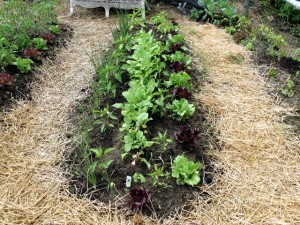 Raised – Mound Vegetable Beds in Early Spring. Image â“’ Michaela at TGE
Raised – Mound Vegetable Beds in Early Spring. Image â“’ Michaela at TGE
 Keeping Good Garden Records is One Way to Learn from both Successes and Failures. It’s Also Fun and Pretty Journals are Lovely Keepsakes Too!
Keeping Good Garden Records is One Way to Learn from both Successes and Failures. It’s Also Fun and Pretty Journals are Lovely Keepsakes Too!
 Timing is everything in the garden! Are you familiar with these odd-looking curlicues? These are tasty garlic scapes, and they are harvested when they form these odd shapes on the top of garlic greens. Scapes have always reminded me of E.T’.s finger. Remember E.T.? Love that little alien. Read all about garlic scapes here.
Timing is everything in the garden! Are you familiar with these odd-looking curlicues? These are tasty garlic scapes, and they are harvested when they form these odd shapes on the top of garlic greens. Scapes have always reminded me of E.T’.s finger. Remember E.T.? Love that little alien. Read all about garlic scapes here.
 Garlic Scape Pesto (click here for recipe and information on the great scapes) â“’ Michaela at TGE
Garlic Scape Pesto (click here for recipe and information on the great scapes) â“’ Michaela at TGE
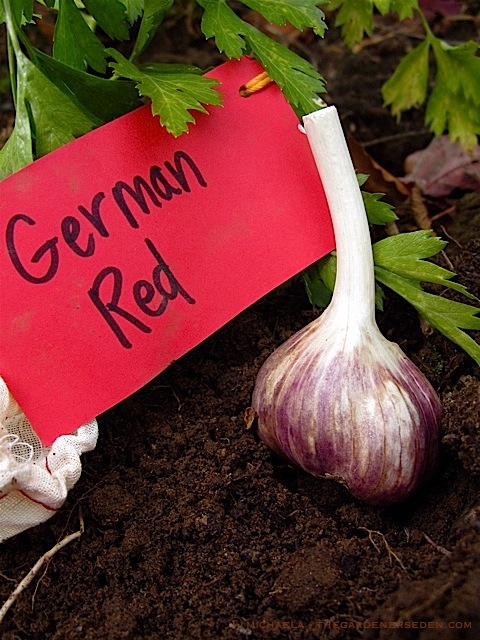 Garlic is a fun, easy and endlessly useful crop. Harvested in late summer/early autumn and planted in the early to late fall, there are many varieties of both hard and soft neck garlic to choose from. Click here for the post, “A Thousand Mothers Set into the Earth: It’s Garlic Planting Season”
Garlic is a fun, easy and endlessly useful crop. Harvested in late summer/early autumn and planted in the early to late fall, there are many varieties of both hard and soft neck garlic to choose from. Click here for the post, “A Thousand Mothers Set into the Earth: It’s Garlic Planting Season”
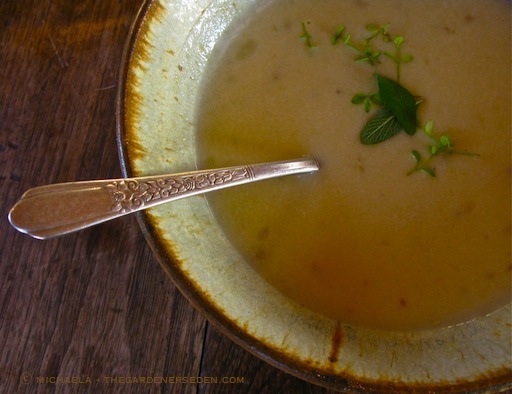 Wonderfully warm and delicious at harvest time and beyond: Creamy Garlic and Potato Soup (click here for recipe)
Wonderfully warm and delicious at harvest time and beyond: Creamy Garlic and Potato Soup (click here for recipe)
 Selecting & Growing the Best Garlic Varieties in Your Garden. Click Here for Post.
Selecting & Growing the Best Garlic Varieties in Your Garden. Click Here for Post.
 Garlic Harvest (Learn to braid garlic or onions in this post here) â“’ Michaela at TGE
Garlic Harvest (Learn to braid garlic or onions in this post here) â“’ Michaela at TGE
 Forage for Fiddleheads, Or Grow Your Own Ostrich Ferns and Have a Fiddlehead Garden All Your Own!
Forage for Fiddleheads, Or Grow Your Own Ostrich Ferns and Have a Fiddlehead Garden All Your Own!
 Delicious Ferncliff Fiddlehead Omelete  (Click Here for Recipe)
Delicious Ferncliff Fiddlehead Omelete  (Click Here for Recipe)
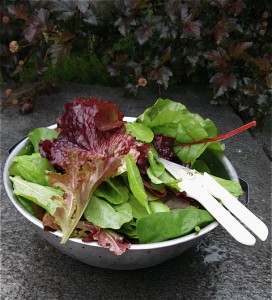 Lettuce, Chard and Arugula. I harvest my own greens year-round. I use hoop-houses to grow arugula, spinach, lettuce and root vegetables throughout the four-seasons; including winter. Image â“’ Michaela at TGE
Lettuce, Chard and Arugula. I harvest my own greens year-round. I use hoop-houses to grow arugula, spinach, lettuce and root vegetables throughout the four-seasons; including winter. Image â“’ Michaela at TGE
 Even though I picked them every summer as a kid, strawberries are still my favorite fruit: First Alpine Strawberry of the Season â“’ Michaela at TGE
Even though I picked them every summer as a kid, strawberries are still my favorite fruit: First Alpine Strawberry of the Season â“’ Michaela at TGE
 Click here for a favorite strawberry shortcake biscuit recipe, and a story about strawberry picking
Click here for a favorite strawberry shortcake biscuit recipe, and a story about strawberry picking
 Alpine Strawberries are Particularly Delicious, and Easy to Grow (click here for Fraises du Bois article)
Alpine Strawberries are Particularly Delicious, and Easy to Grow (click here for Fraises du Bois article)
 Blueberry Breakfast Popover Recipe (click here)
Blueberry Breakfast Popover Recipe (click here)
 Rhapsody in Blue: Selecting and Planting High-Bush Blueberries (plus a recipe for Blueberry Lemon Bread) Image ⓒ Michaela at TGE
Rhapsody in Blue: Selecting and Planting High-Bush Blueberries (plus a recipe for Blueberry Lemon Bread) Image â“’ Michaela at TGE
 Blueberry Hill Pancakes (click here for recipe)
Blueberry Hill Pancakes (click here for recipe)
 Highbush and Lowbush blueberries make beautiful, ornamentals as well; with strong autumn color and blossoms to attract beneficials, like bees!
Highbush and Lowbush blueberries make beautiful, ornamentals as well; with strong autumn color and blossoms to attract beneficials, like bees!
 First Broccoli, Late Spring 2009 â“’ Michaela at TGE
First Broccoli, Late Spring 2009 â“’ Michaela at TGE
 Red-Hot Chili Peppers â“’ Michaela at TGE
Red-Hot Chili Peppers â“’ Michaela at TGE
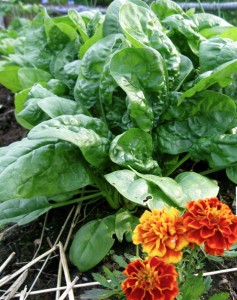 Spinach and marigold companions: click here for article on companion planting
Spinach and marigold companions: click here for article on companion planting
 Spicy Cream-of-Carrot & Ginger Soup (click here for recipe). Image â“’ Michaela at TGE
Spicy Cream-of-Carrot & Ginger Soup (click here for recipe). Image â“’ Michaela at TGE
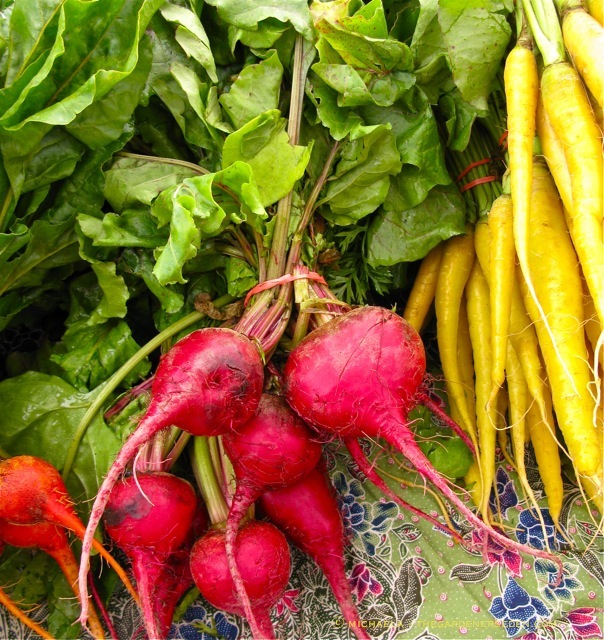 Carrot seeds are “waskilly”, or notoriously difficult to sow. This article offers a bit of advice, and this one (on companion planting) may help you too!
Carrot seeds are “waskilly”, or notoriously difficult to sow. This article offers a bit of advice, and this one (on companion planting) may help you too!
 Baked Velvet Carrots and Carrot-Seed-Sowing Tips (click here for recipe and article)
Baked Velvet Carrots and Carrot-Seed-Sowing Tips (click here for recipe and article)
 Companion Planting Makes Sense with Tricky to Sow and Spot Crops like Carrots: Click here for more info.
Companion Planting Makes Sense with Tricky to Sow and Spot Crops like Carrots: Click here for more info.
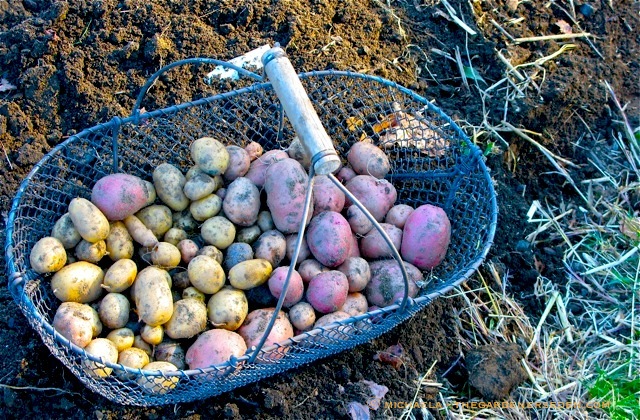 My mother is a citizen of Germany, and most of my extended family lives in Europe, so as you might guess: I grow, and love, potatoes!
My mother is a citizen of Germany, and most of my extended family lives in Europe, so as you might guess: I grow, and love, potatoes!
 Sure, you can grow plain, white potatoes. But why not fill your plate with varied colors and flavors from around the world?
Sure, you can grow plain, white potatoes. But why not fill your plate with varied colors and flavors from around the world?
 Favorite Potato Salad Recipe: Pommes À L’Huile (click here)
Favorite Potato Salad Recipe: Pommes À L’Huile (click here)
 Gourmet Potatoes in August â“’ Michaela at TGE
Gourmet Potatoes in August â“’ Michaela at TGE
 Penne with Roasted Potatoes, Arugula and Rosemary – Click Here for Recipe
Penne with Roasted Potatoes, Arugula and Rosemary – Click Here for Recipe
 I love this recipe for Parmesan-Coated, Roasted Fingerlings (click here for details)
I love this recipe for Parmesan-Coated, Roasted Fingerlings (click here for details)
 I also grow plenty of potatoes for root-cellaring, because come late fall and winter, I love keeping warm with this old family favorite: Potato-Cheddar soup with Beer (click here for recipe)
I also grow plenty of potatoes for root-cellaring, because come late fall and winter, I love keeping warm with this old family favorite: Potato-Cheddar soup with Beer (click here for recipe)
 Summer Squash, Beans and Cucumbers from the Potager â“’ Michaela at TGE
Summer Squash, Beans and Cucumbers from the Potager â“’ Michaela at TGE
 Romanesco Broccoli â“’ Michaela at TGE
Romanesco Broccoli â“’ Michaela at TGE
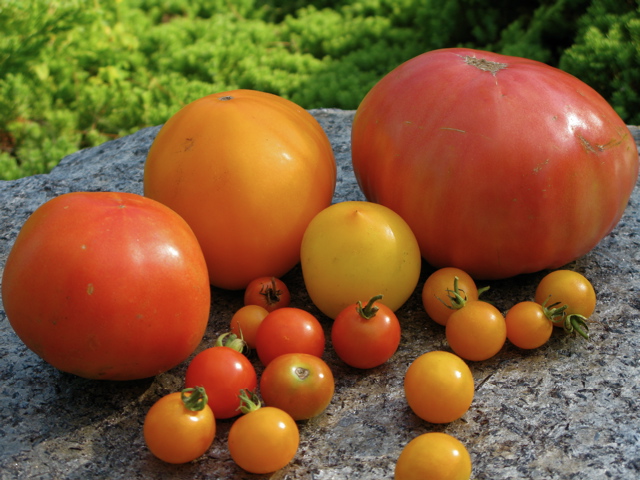 Heirloom, Modern and Cherry Tomatoes from the Potager, Summer 2009 â“’ Michaela at TGE
Heirloom, Modern and Cherry Tomatoes from the Potager, Summer 2009 â“’ Michaela at TGE
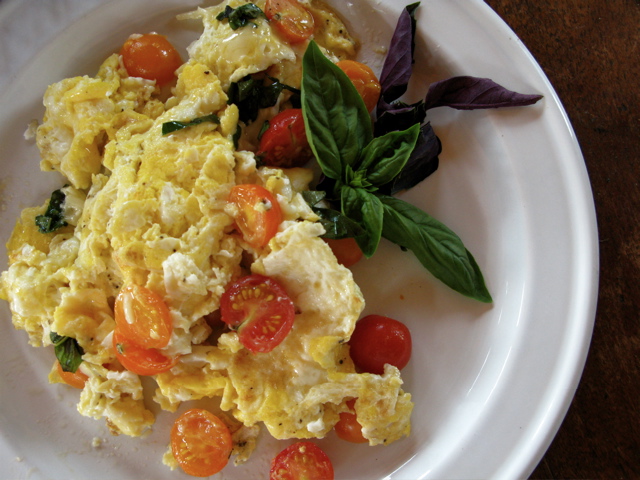 Breakfast of Scrambled Eggs, Cherry Tomatoes, Basil and Garlic Summer 2009 â“’ Michaela at TGE
Breakfast of Scrambled Eggs, Cherry Tomatoes, Basil and Garlic Summer 2009 â“’ Michaela at TGE
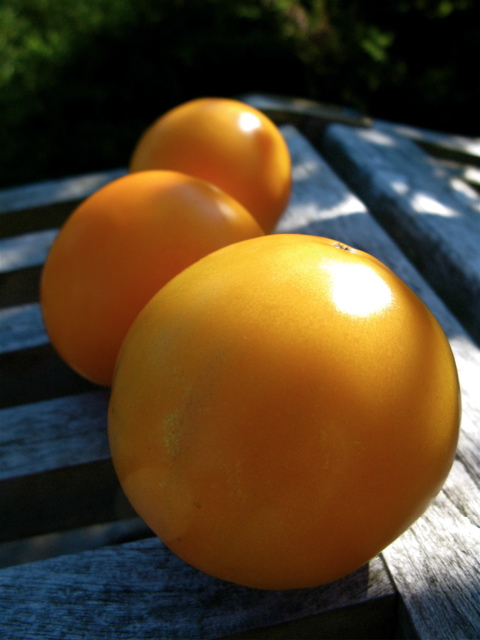 Orange Blossom Tomato Harvest 2009 â“’ Michaela at TGE
Orange Blossom Tomato Harvest 2009 â“’ Michaela at TGE
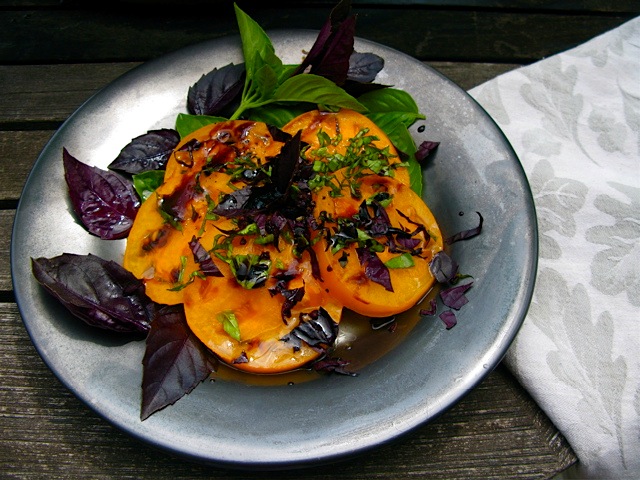 When it Strikes, Late Blight Is a Serious Problem, Wiping Out Entire Tomato Crops. Click Here for Information and Resources. Precious Orange Blossom Tomatoes in a Salad – Summer 2009. Image â“’ Michaela at TGE
When it Strikes, Late Blight Is a Serious Problem, Wiping Out Entire Tomato Crops. Click Here for Information and Resources. Precious Orange Blossom Tomatoes in a Salad – Summer 2009. Image â“’ Michaela at TGE
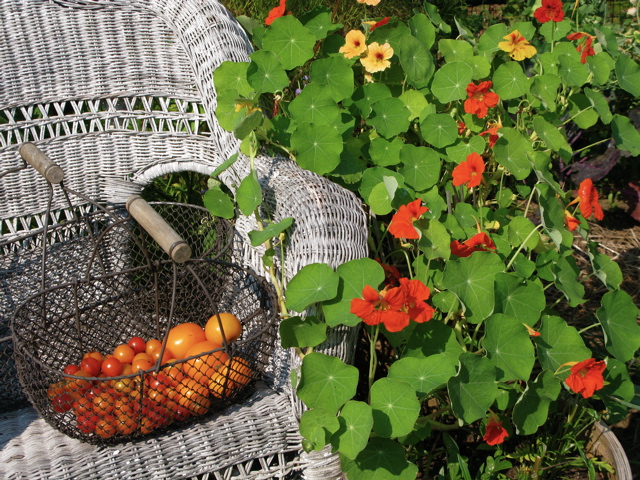 Early Tomato Harvest and Nasturtiums in the Potager â“’ Michaela at TGE
Early Tomato Harvest and Nasturtiums in the Potager â“’ Michaela at TGE
 Sungold Tomatoes â“’ Michaela at TGE
Sungold Tomatoes â“’ Michaela at TGE
 Golden Days of Summer Gazpacho (click here for recipe) â“’ Michaela at TGE
Golden Days of Summer Gazpacho (click here for recipe) â“’ Michaela at TGE
 The Potager in July 2010 â“’ Michaela at TGE
The Potager in July 2010 â“’ Michaela at TGE
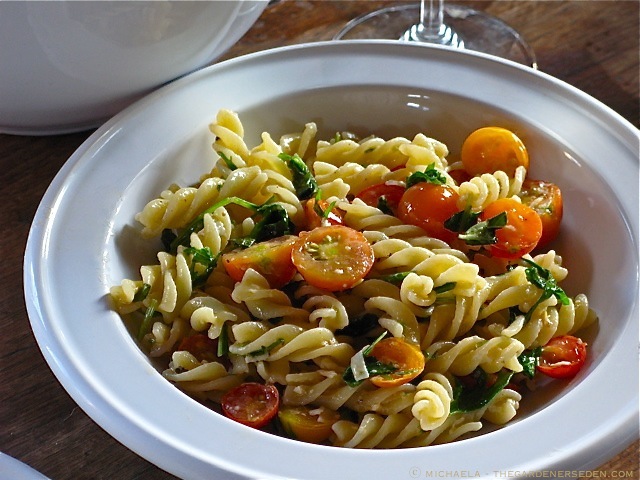 A Lovely, Early-Summer Dinner: Cold Pasta with Sungold Cherry Tomatoes, Arugula and Cheese – Click Here for Recipe and Links to Some Favorite Food Blogs!
A Lovely, Early-Summer Dinner: Cold Pasta with Sungold Cherry Tomatoes, Arugula and Cheese – Click Here for Recipe and Links to Some Favorite Food Blogs!
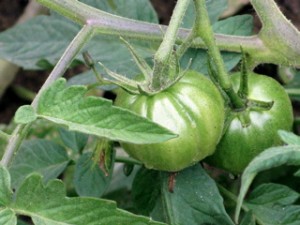 Orange Blossom Tomatoes â“’ Michaela at TGE
Orange Blossom Tomatoes â“’ Michaela at TGE
 Orange Blossom and Early Girl Tomatoes with Ruby Red Chard
Orange Blossom and Early Girl Tomatoes with Ruby Red Chard
 Hoophouses give cold climate tomato gardeners an early jump in spring, and help extend the season in fall. Click here for hoophouse tutorial.
Hoophouses give cold climate tomato gardeners an early jump in spring, and help extend the season in fall. Click here for hoophouse tutorial.
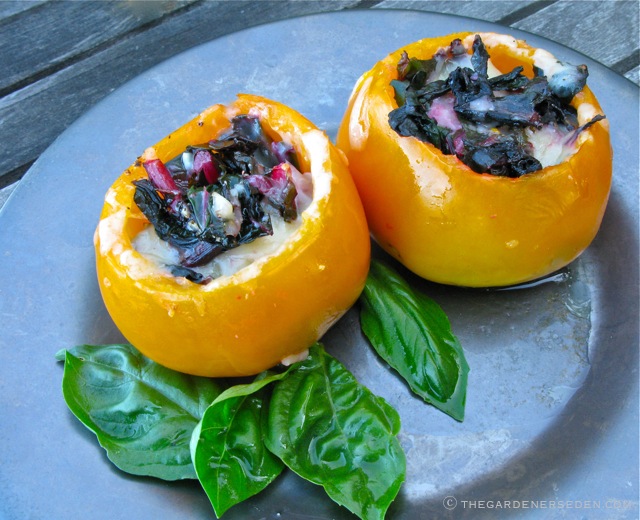 Oven-Roasted Tomatoes, Stuffed with Ruby Red Chard, Fresh Herbs and Vermont Cheddar – Click Here for Recipe
Oven-Roasted Tomatoes, Stuffed with Ruby Red Chard, Fresh Herbs and Vermont Cheddar – Click Here for Recipe
 I grow many kinds of tomatoes. Some are eaten fresh from the garden, some are canned and some are sun-dried...
I grow many kinds of tomatoes. Some are eaten fresh from the garden, some are canned and some are sun-dried...
 Drying Tomatoes the Old Fashioned Way… In the Sun!
Drying Tomatoes the Old Fashioned Way… In the Sun!
 Once Dried, Tomatoes are Sealed in Jars of Olive Oil
Once Dried, Tomatoes are Sealed in Jars of Olive Oil
 I then store my sun-dried tomatoes in the pantry & fridge to use throughout fall, winter and spring
I then store my sun-dried tomatoes in the pantry & fridge to use throughout fall, winter and spring
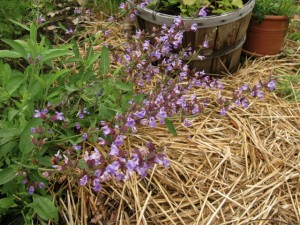 Companion Planting in the Potager – Sage 2009 – â“’ Michaela at TGE
Companion Planting in the Potager – Sage 2009 – â“’ Michaela at TGE
 Cucumbers like to Climb! They also do well with flowers planted nearby (to attract bees for better pollination). Raider and Lemon Cucumbers on the Potager Fence: Click here for information on growing cucumbers and for cucumber salad recipe
Cucumbers like to Climb! They also do well with flowers planted nearby (to attract bees for better pollination). Raider and Lemon Cucumbers on the Potager Fence: Click here for information on growing cucumbers and for cucumber salad recipe
 Tante Maria’s Gurkensalat (click here for recipe) Image â“’ Michaela at TGE
Tante Maria’s Gurkensalat (click here for recipe) Image â“’ Michaela at TGE
 Lemon Cucumbers Climbing Along the Potager Fence. Image â“’ Michaela at TGE
Lemon Cucumbers Climbing Along the Potager Fence. Image â“’ Michaela at TGE
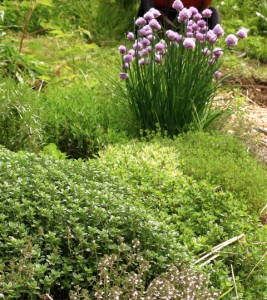 Herbs, Including Thyme, Savory, Rosemary and Chives are Grown Throughout the Potager. Image â“’ Michaela at TGE
Herbs, Including Thyme, Savory, Rosemary and Chives are Grown Throughout the Potager. Image â“’ Michaela at TGE
 Squash plants are prone to powdery mildew. Click here for an easy & economical home remedy and a recipe for summertime risotto (pictured below) Freshly Harvested Zucchini and Yellow Summer Squash. Image â“’ Michaela at TGE
Squash plants are prone to powdery mildew. Click here for an easy & economical home remedy and a recipe for summertime risotto (pictured below) Freshly Harvested Zucchini and Yellow Summer Squash. Image â“’ Michaela at TGE
 Summertime Risotto with Zucchini and Peppers is Lovely on a Rainy, Late-Summer Day or Evening (Click Here for Recipe)
Summertime Risotto with Zucchini and Peppers is Lovely on a Rainy, Late-Summer Day or Evening (Click Here for Recipe)
 Spiced Zucchini Bread Recipe. Image â“’ Michaela at TGE
Spiced Zucchini Bread Recipe. Image â“’ Michaela at TGE
 Zucchini Bread and Wild Blackberries â“’ Michaela at TGE
Zucchini Bread and Wild Blackberries â“’ Michaela at TGE
 The Kitchen Garden After Rain â“’ Michaela at TGE
The Kitchen Garden After Rain â“’ Michaela at TGE
 Harvesting Haricots Verts Image â“’ Michaela at TGE
Harvesting Haricots Verts Image â“’ Michaela at TGE
 Click Here for: Chilled Green Bean and Feta Salad Recipe. Image â“’ Michaela at TGE
Click Here for: Chilled Green Bean and Feta Salad Recipe. Image â“’ Michaela at TGE
 I love green beans, and my favorites are the thin, French-style Haricots Verts: for growing tips, click here â“’ Michaela at TGE
I love green beans, and my favorites are the thin, French-style Haricots Verts: for growing tips, click here â“’ Michaela at TGE
 I move furniture around to create different outdoor dining areas. See this post for more al fresco dining inspiration. Image â“’ Michaela at TGE
I move furniture around to create different outdoor dining areas. See this post for more al fresco dining inspiration. Image â“’ Michaela at TGE
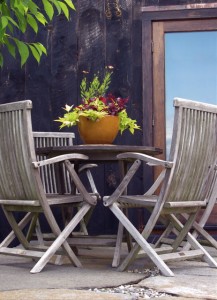 One of the great pleasures of creating a garden, is the opportunity to dine in a beautiful outdoor space. Stone Terrace and Outdoor Dining Table -Image â“’ Michaela at TGE
One of the great pleasures of creating a garden, is the opportunity to dine in a beautiful outdoor space. Stone Terrace and Outdoor Dining Table -Image â“’ Michaela at TGE
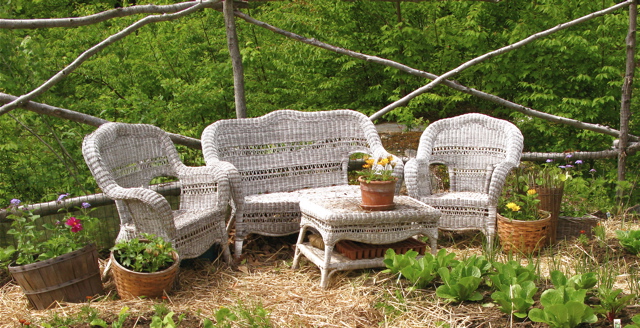 Dining amongst the vegetables is often the best place of all.
Dining amongst the vegetables is often the best place of all.
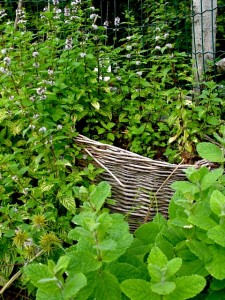 The Mint Garden. Image â“’ Michaela at TGE
The Mint Garden. Image â“’ Michaela at TGE
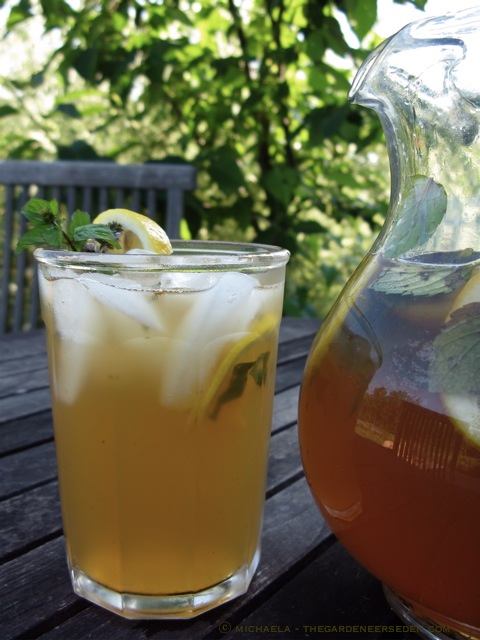 Lemon-Mint Sun Tea on the Terrace. Click here for recipe. â“’ Michaela at TGE
Lemon-Mint Sun Tea on the Terrace. Click here for recipe. â“’ Michaela at TGE
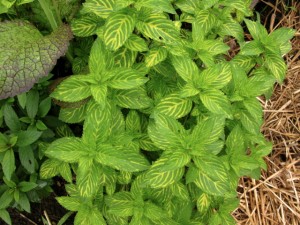 Pineapple Mint â“’ Michaela at TGE
Pineapple Mint â“’ Michaela at TGE
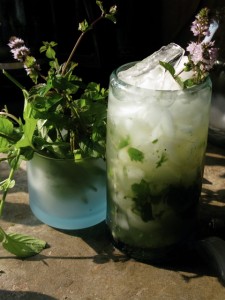 Cuban Mint Julep. Click here for recipe and story. Image â“’ Michaela at TGE
Cuban Mint Julep. Click here for recipe and story. Image â“’ Michaela at TGE
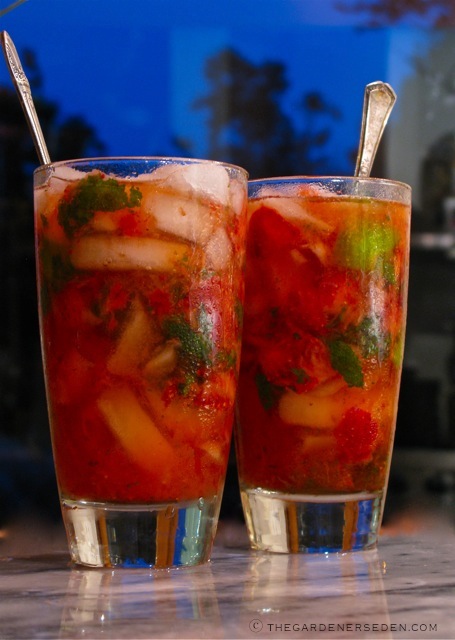 Strawberry-Mint Mojitos from the Garden. Click here for recipe.
Strawberry-Mint Mojitos from the Garden. Click here for recipe.
 Vintage Rose Cocktail Recipe: Click Here
Vintage Rose Cocktail Recipe: Click Here
 Sorting, Bundlingand Prepping Herbs for Storage. For information on how to dry herbs, click here. â“’ Michaela at TGE
Sorting, Bundlingand Prepping Herbs for Storage. For information on how to dry herbs, click here. â“’ Michaela at TGE
 Herb Harvest â“’ Michaela at TGE
Herb Harvest â“’ Michaela at TGE
 Frozen Herb Cubes (in olive oil, broth, water or butter) Can Be Pulled from the Freezer to Give Fresh, Herbal Infused Flavor to Winter Dishes (click here for tutorial and other links for help with putting food by)
Frozen Herb Cubes (in olive oil, broth, water or butter) Can Be Pulled from the Freezer to Give Fresh, Herbal Infused Flavor to Winter Dishes (click here for tutorial and other links for help with putting food by)
 There are many ways to store home-grown herbs. One of my favorite late-summer activities is bundling and drying herbs in August. Click here for information on how and when to dry herbs. â“’ Michaela at TGE
There are many ways to store home-grown herbs. One of my favorite late-summer activities is bundling and drying herbs in August. Click here for information on how and when to dry herbs. â“’ Michaela at TGE
 Chives Surrounded by Various Thyme â“’ Michaela at TGE
Chives Surrounded by Various Thyme â“’ Michaela at TGE
 Dahlia and Calendula from the Potager, 2009 â“’ Michaela at TGE
Dahlia and Calendula from the Potager, 2009 â“’ Michaela at TGE
 Fresh Salad â“’ Michaela at TGE
Fresh Salad â“’ Michaela at TGE
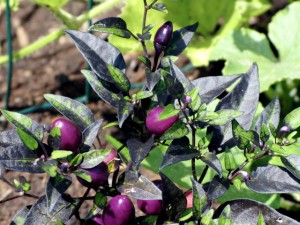 Ornamental Purple Peppers in the Potager â“’ Michaela at TGE
Ornamental Purple Peppers in the Potager â“’ Michaela at TGE
 Penne with Peppers and Kale â“’ Michaela at TGE
Penne with Peppers and Kale â“’ Michaela at TGE
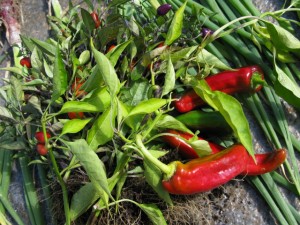 Hot Hungarian Peppers on the Terrace â“’ Michaela at TGE
Hot Hungarian Peppers on the Terrace â“’ Michaela at TGE
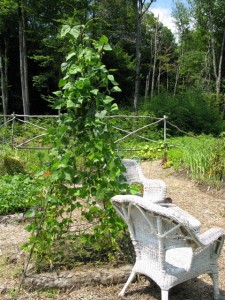 The Newly Installed  Copper Bean Pole. Image ⓒ Michaela at TGE
The Newly Installed  Copper Bean Pole. Image ⓒ Michaela at TGE
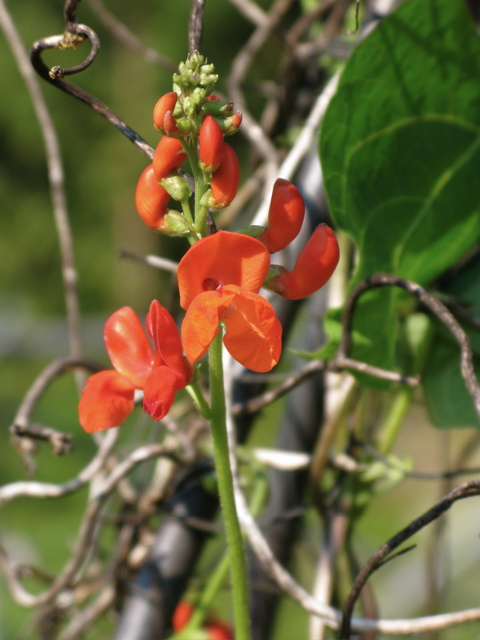 Scarlet Runner Bean, Blossoming on the TeePee. Image â“’ Michaela at TGE
Scarlet Runner Bean, Blossoming on the TeePee. Image â“’ Michaela at TGE
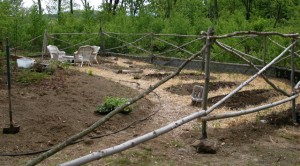 The new, sapling fence installation â“’ Michaela at TGE
The new, sapling fence installation â“’ Michaela at TGE
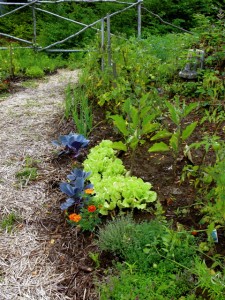 Newly planted herbs and vegetables in the spring kitchen garden. Image â“’ Michaela at TGE
Newly planted herbs and vegetables in the spring kitchen garden. Image â“’ Michaela at TGE
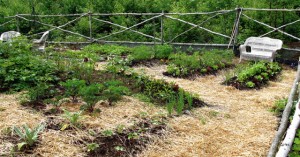 The new sapling fence in the kitchen garden, late spring. Image â“’ Michaela at TGE
The new sapling fence in the kitchen garden, late spring. Image â“’ Michaela at TGE
 I grow extra leeks each year, so that I can store them in the root cellar and enjoy them throughout winter. Click here for tips and a delicious soup recipe!
I grow extra leeks each year, so that I can store them in the root cellar and enjoy them throughout winter. Click here for tips and a delicious soup recipe!
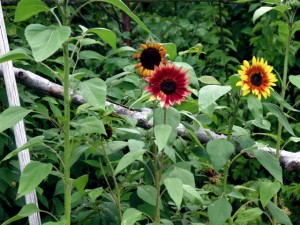 Autumn Beauty Sunflowers Along the Fence, Late Summer. Image â“’ Michaela at TGE
Autumn Beauty Sunflowers Along the Fence, Late Summer. Image â“’ Michaela at TGE
 Potato-Leek Soup Recipe: Plus, Tips on Storing Leeks in the Root Cellar (Click Here)!
Potato-Leek Soup Recipe: Plus, Tips on Storing Leeks in the Root Cellar (Click Here)!
 Gourmet Onions in the Potager, Early Summer. Image â“’ Michaela at TGE
Gourmet Onions in the Potager, Early Summer. Image â“’ Michaela at TGE
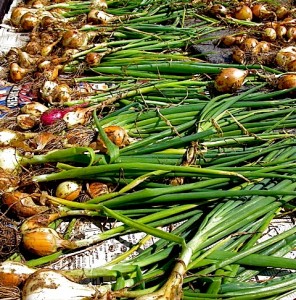 Onion Harvest. For more information on growing and harvesting onions —plus my favorite French Onion Soup recipe— click here. Image â“’ Michaela at TGE
Onion Harvest. For more information on growing and harvesting onions —plus my favorite French Onion Soup recipe— click here. Image â“’ Michaela at TGE
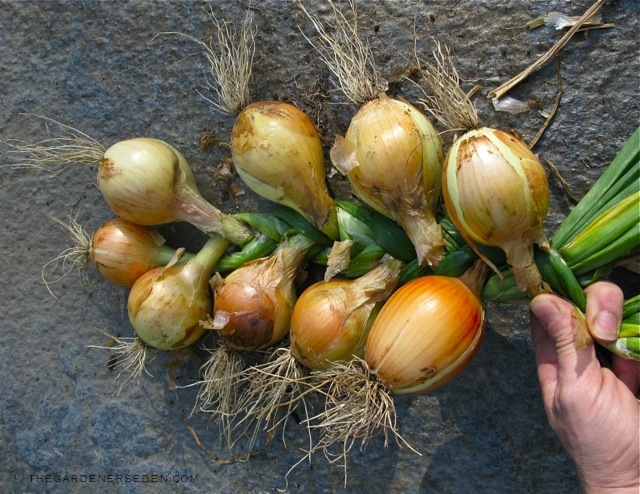 Braiding Onions for Storage. Click here for tutorial post. â“’ Michaela at TGE
Braiding Onions for Storage. Click here for tutorial post. â“’ Michaela at TGE
 Sweet Onion Braid. Click here to learn how to make one, and store your onions, country style. Image â“’ Michaela at TGE
Sweet Onion Braid. Click here to learn how to make one, and store your onions, country style. Image â“’ Michaela at TGE
 Growing your own gourmet crops, like shiitake mushrooms, can allow you to eat like a royal, on a ragamuffin’s budget. Click here for shiitake growing tutorial.
Growing your own gourmet crops, like shiitake mushrooms, can allow you to eat like a royal, on a ragamuffin’s budget. Click here for shiitake growing tutorial.
 Shiitake Mushroom Harvest â“’ Michaela at TGE
Shiitake Mushroom Harvest â“’ Michaela at TGE
 The shiitake garden at my house is now triple this size. For a tutorial on shiitake mushroom growing, click here.
The shiitake garden at my house is now triple this size. For a tutorial on shiitake mushroom growing, click here.
 Zucca Disfatta – Sweet, Sauteed Butternut Squash and Yams – Click here for Recipe
Zucca Disfatta – Sweet, Sauteed Butternut Squash and Yams – Click here for Recipe
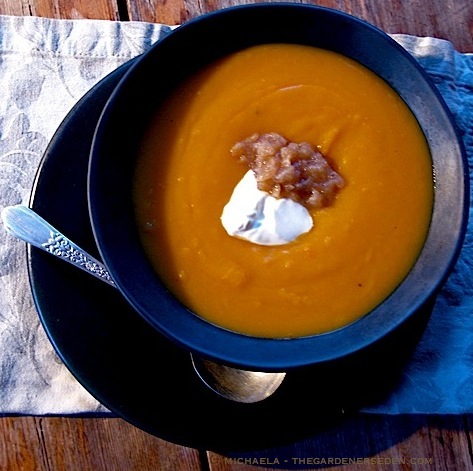 Butternut Squash Soup with Apple Confit – Click Here for Recipe
Butternut Squash Soup with Apple Confit – Click Here for Recipe
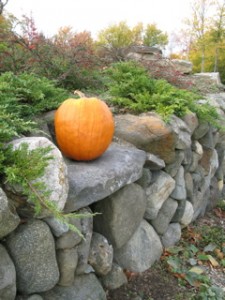 Produce Displayed on the Entry Garden Wall in Autumn â“’ Michaela at TGE
Produce Displayed on the Entry Garden Wall in Autumn â“’ Michaela at TGE
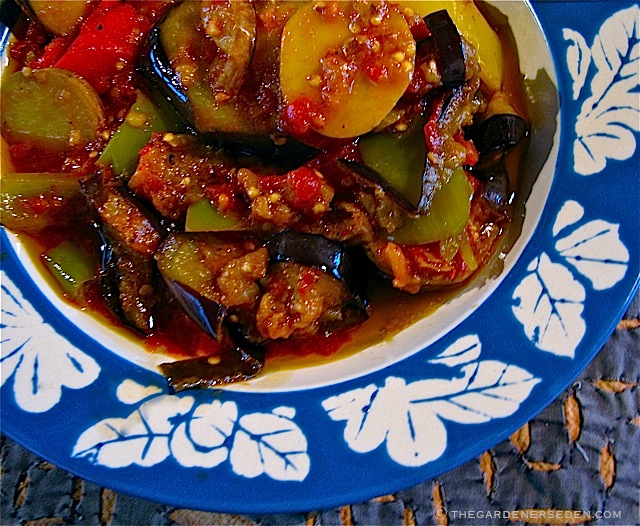 When September and October Arrive, Summer Produce is Plentiful in the Potager. On Cool Days, I Love This Autumn Harvest Stew (Click Here for Recipe)
When September and October Arrive, Summer Produce is Plentiful in the Potager. On Cool Days, I Love This Autumn Harvest Stew (Click Here for Recipe)
 Tomatoes, Peppers and Eggplant Continue to Ripen Past the early October Frost When Protected Inside Hoophouses (see below). Image â“’ Michaela at TGE
Tomatoes, Peppers and Eggplant Continue to Ripen Past the early October Frost When Protected Inside Hoophouses (see below). Image â“’ Michaela at TGE
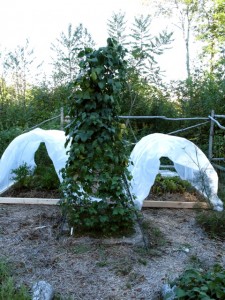 The first two hoophouse cold-frames were installed here in the autumn of 2008 (click here for how-to building tutorial) Image â“’ Michaela at TGE
The first two hoophouse cold-frames were installed here in the autumn of 2008 (click here for how-to building tutorial) Image â“’ Michaela at TGE
 Hoophouses help protect tender crops from frost —like these tomatoes and basil, shown in the late fall— Â and give them a jump start in the early spring.
Hoophouses help protect tender crops from frost —like these tomatoes and basil, shown in the late fall— Â and give them a jump start in the early spring.
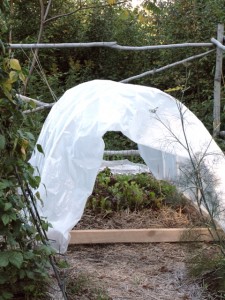 Late season crops —sown beneath the protection of the hoophouse in early-mid autumn— continue the vegetable harvest into the new year â“’ Michaela at TGE
Late season crops —sown beneath the protection of the hoophouse in early-mid autumn— continue the vegetable harvest into the new year â“’ Michaela at TGE
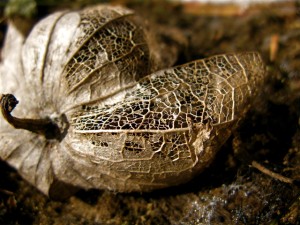 The Garden in Winter: Tomatillo Husk. Image â“’ Michaela at TGE
The Garden in Winter: Tomatillo Husk. Image â“’ Michaela at TGE
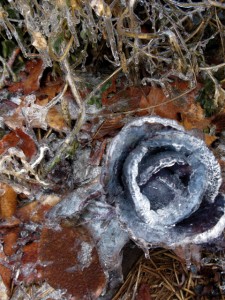 Remnants of the Kitchen Garden: Cabbage in Winter, 2008-09 Â â“’ Michaela at TGE
Remnants of the Kitchen Garden: Cabbage in Winter, 2008-09 Â â“’ Michaela at TGE
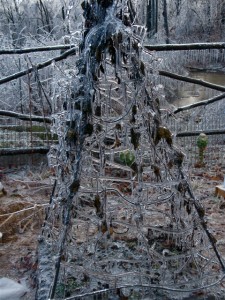 Bean Pole in the Ice Storm 2009. Image â“’ Michaela at TGE
Bean Pole in the Ice Storm 2009. Image â“’ Michaela at TGE
 The Kitchen Garden Room – Ice Storm of 2009. Image â“’ Michaela at TGE
The Kitchen Garden Room – Ice Storm of 2009. Image â“’ Michaela at TGE
***
All photos are from Ferncliff. Garden design, installation and all photos: Michaela at The Gardener’s Eden
Design Inquiries Please Email: michaela (at) the gardeners eden (dot) com
Sapling fence installation and hoop house construction, special thanks to: William B.
Please do not post, use or reproduce photographs or articles without permission. Ask me… I am usually happy to share. Thank you!
***
